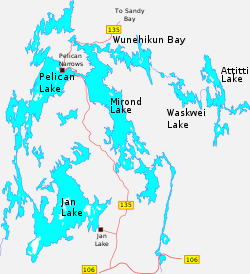Mirond Lake
Mirond Lake is a lake in Saskatchewan, Canada. It lies in low-relief forested terrain of the Canadian Shield. The climate is sub-arctic.
| Mirond Lake | |
|---|---|
 Mirond (center) and surrounding lakes | |
 Mirond Lake Location is Saskatchewan | |
| Coordinates | 55.1000712°N 102.7837384°W |
| Type | Lake |
| Basin countries | Canada |
Location
Mirond Lake (HALPR) is at 55.1000712°N 102.7837384°W.[1] The lake is accessible by road north from the Hanson Lake Road (Saskatchewan Highway 106).[2] It is about 24 miles (39 km) long and 5 miles (8.0 km) wide at its widest point.[3] Mirond Lake is joined to Pelican Lake to the west by a narrow stretch of water that gives its name to the community of Pelican Narrows on its north shore.[4] Attitti Lake to the east drains through Waskwei Lake and Wunehikun Bay into Mirond Lake.[5] Pelican and Mirond lakes are near the 400 metres (1,300 ft) high point of the Flin Flon Plain, which slopes gently to the south down to about 330 metres (1,080 ft) at Deschambault Lake and Amisk Lake.[6]
Mirond lake is the headwaters of the Sturgeon-Weir River, a tributary to Cumberland Lake.[7] This in turn drains into the Saskatchewan River System.[5] The Sturgeon-Wier leaves the end of the lake through a rock-walled channel containing a section of rapids, then flows more slowly through a series of long, narrow lakes.[8] The river drains a large system of lakes between latitudes 54°30' and 55°30' and longitudes 102° and 103°, including Deschambault Lake, Wood Lake, Pelican Lake and Mirond Lake. It empties into Beaver Lake, about 90 miles (140 km) northwest of The Pas, Manitoba. The river is about 50 miles (80 km) long from Mirond Lake to Beaver Lake. Above Scoop Rapids, about half way along the river, the drainage area is about 5,678 square miles (14,710 km2).[9]
Etymology
The name "mi-rond" is French and means "half round", or "half moon" according to Sir John Richardson.[10] It describes the shape of the lake.[7] Peter Pond, a poor speller, showed the lake as "Mineront" in his maps drawn around 1785. Other variants were used later, such as Merion. Sir John Franklin on his overland expedition of 1819-22 wrote "Miron" as "Heron", and this was copied by several other map makers. The name Mirond is standard now.[11] The Cree give the twin lakes of Pelican and Mirond the name Opawikoschikun Sakuhikuna, or "fear lakes", referring to a massacre that took place there around 1730.[10] The Cree name for the narrows is Opawikoscikcan, meaning "fear narrows".[4]
Climate
The lake is in the subarctic climate zone.[12] The annual average temperature is −1 °C (30 °F). The warmest month is July, when the average temperature is 16 °C (61 °F) and the coldest is January, with −24 °C (−11 °F).[13]
Environment
The landscape has areas of glaciolacustrine silts and clays or sandy glacial till, with many outcrops of Precambrian rocks that have been scoured by glacial ice. There are large areas of peatland in the poorly drained areas, and elsewhere the land is forested. Black spruce (picea mariana) is common but not dominant, and other trees include white spruce (picea glauca), trembling aspen (populus tremuloides), jack pine (pinus banksiana) and balsam fir (abies balsamea).[6] The lake has lodges with cabins and campgrounds for fishing and hunting.[14][15] A Saskatchewan live release record for northern pike was set at Mirond Lake in 2008, with a 141 centimetres (56 in) specimen.[16]
Notes
- Mirond Lake – Natural Resources.
- Fly or Drive – Tourism Saskatchewan.
- Directions – Newmart Resort.
- Pelican Narrows – Tourism Saskatchewan.
- Pyke 1961, p. 5.
- Padbury, Acton & Stushnoff 1998, p. 71.
- Canada. Parliament 1918, p. 173.
- Finkelstein 2005, p. 252.
- Canada. Parliament 1918, p. 44.
- Green et al. 2003.
- Russell 2015.
- Peel, Finlayson & McMahon 2007.
- Dataset Index – NASA.
- Bayview Lodge – Tourism Saskatchewan.
- Silence of the North – Tourism Saskatchewan.
- What You'll Catch – Tourism Saskatchewan.
Sources
- Bayview Lodge, Tourism Saskatchewan, retrieved 2018-06-26
- Canada. Parliament (1918), Sessional Papers of the Dominion of Canada, retrieved 2018-06-27
- "Dataset Index", NASA Earth Observations Data, NASA, retrieved 30 January 2016
- Directions, Newmart Resort, retrieved 2018-06-27
- Finkelstein, Max (2005-03-21), Canoeing a Continent: On the Trail of Alexander Mackenzie, Dundurn, ISBN 978-1-77070-634-7, retrieved 2018-06-27
- Fly or Drive, Tourism Saskatchewan, retrieved 2018-06-26
- Green, Ted; Green, Scott; Todd, Chris; Todd, Bella (2003), June 12th, 2003, KCDC: Keewatin Career Development Corporation, retrieved 2018-06-27
- Mirond Lake, Natural Resources Canada, retrieved 2018-06-26
- Padbury, G. A.; Acton, Donald F.; Stushnoff, Colette T. (1998), Ecoregions of Saskatchewan, University of Regina Press, ISBN 978-0-88977-097-3, retrieved 2018-06-27
- Peel, M C; Finlayson, B L; McMahon, T A (2007), "Updated world map of the Köppen-Geiger climate classification", Hydrology and Earth System Sciences 11, doi:10.5194/hess-11-1633-2007
- Pelican Narrows, Tourism Saskatchewan, retrieved 2018-06-26
- Pyke, M. W. (1961), The Geology of the Attitti Lake Area (West Half) Saskatchewan (PDF), Saskatchewan Department of Mineral Resources, archived from the original (PDF) on 2018-11-09, retrieved 2018-06-24
- Russell, Dale R. (2015-01-18), Historical Names Along the Sturgeon-weir River, retrieved 2018-06-26
- Silence of the North, Tourism Saskatchewan, retrieved 2018-06-26
- What You'll Catch, Tourism Saskatchewan, retrieved 2018-06-26